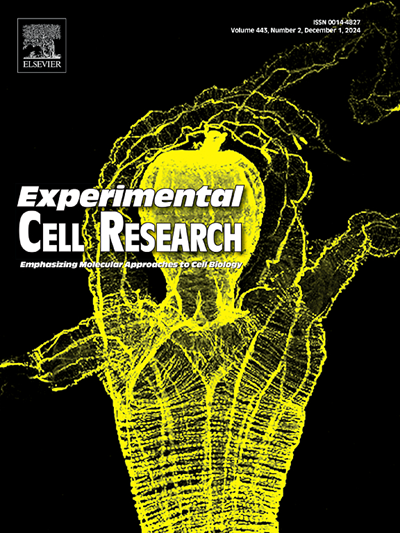通过NF-κB通路介导的G0/ g1期细胞周期阻滞,抑制AGTR1可减弱青光眼滤过术后细胞增殖
IF 3.3
3区 生物学
Q3 CELL BIOLOGY
引用次数: 0
摘要
青光眼滤过手术(GFS)后成纤维细胞增殖在瘢痕形成中起关键作用。血管紧张素1型受体(AGTR1)参与组织重塑。我们之前的研究表明,使用AGTR1阻滞剂治疗可以延长GFS后滤过泡的存活时间。然而,AGTR1是否参与GFS后成纤维细胞增殖尚不清楚。本研究探讨了AGTR1参与GFS后细胞增殖激活的机制。AGTR1在青光眼患者的Tenon囊组织中表达升高。AGTR1抑制导致TGF-β2诱导的人Tenon胶囊成纤维细胞(HTF)增殖减少,GFS后结膜下细胞增殖减轻。此外,AGTR1的低表达通过p21Waf1/Cip1/Cyclin D/Cyclin E途径导致G0/G1期HTFs的比例增加。此外,加入NF-κB通路阻断剂BAY 11-7082,可进一步抑制Ki67、Cyclin D和Cyclin E的表达,并增加G0/G1期HTFs的百分比。总之,我们的研究结果表明,AGTR1抑制可以通过NF-κB途径导致细胞周期阻滞在G0/G1期,从而减弱HTF的增殖。靶向AGTR1是缓解GFS后细胞增殖的可行策略。本文章由计算机程序翻译,如有差异,请以英文原文为准。
Inhibition of AGTR1 attenuates cell proliferation after glaucoma filtration surgery via NF-κB pathway–mediated G0/G1-phase cell cycle arrest
Fibroblast proliferation after glaucoma filtration surgery (GFS) plays a pivotal role in scar formation. Angiotensin type 1 receptor (AGTR1) is involved in tissue remodeling. Our previous study demonstrated that treatment with an AGTR1 blocker prolonged the survival of filtering blebs following GFS. However, whether AGTR1 participates in fibroblast proliferation after GFS remains unclear. This study examined the mechanisms underlying the involvement of AGTR1 in the activation of cell proliferation following GFS. AGTR1 expression was increased in Tenon capsule tissue of patients with glaucoma. AGTR1 inhibition resulted in a decrease in TGF-β2-induced human Tenon capsule fibroblast (HTF) proliferation and a mitigation of subconjunctival cell proliferation following GFS. Additionally, lower AGTR1 expression led to a higher percentage of HTFs in the G0/G1 phase via the p21Waf1/Cip1/Cyclin D/Cyclin E pathway. Furthermore, the addition of BAY 11–7082, a blocker of the NF-κB pathway, resulted in further inhibition of Ki67, Cyclin D, and Cyclin E expressions and an increase in the percentage of HTFs in the G0/G1 phase. In conclusion, our findings indicate that AGTR1 inhibition can attenuate HTF proliferation by leading to cell cycle arrest in the G0/G1 phase through the NF-κB pathway. Targeting AGTR1 is a feasible strategy for mitigating cell proliferation following GFS.
求助全文
通过发布文献求助,成功后即可免费获取论文全文。
去求助
来源期刊

Experimental cell research
医学-细胞生物学
CiteScore
7.20
自引率
0.00%
发文量
295
审稿时长
30 days
期刊介绍:
Our scope includes but is not limited to areas such as: Chromosome biology; Chromatin and epigenetics; DNA repair; Gene regulation; Nuclear import-export; RNA processing; Non-coding RNAs; Organelle biology; The cytoskeleton; Intracellular trafficking; Cell-cell and cell-matrix interactions; Cell motility and migration; Cell proliferation; Cellular differentiation; Signal transduction; Programmed cell death.
 求助内容:
求助内容: 应助结果提醒方式:
应助结果提醒方式:


